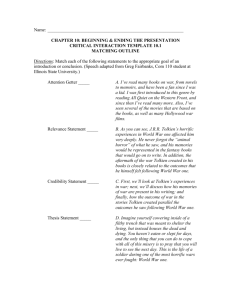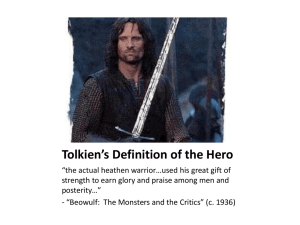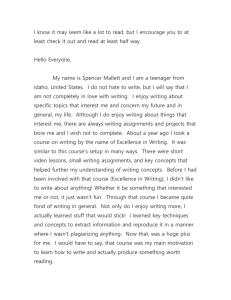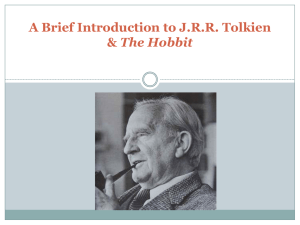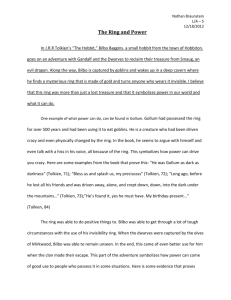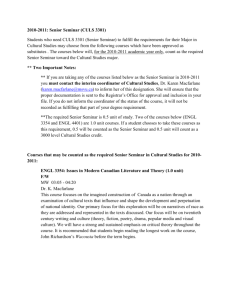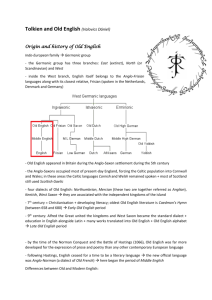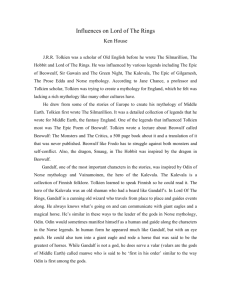JRR TOLKIEN BIOGRAPHY NOTES/
advertisement
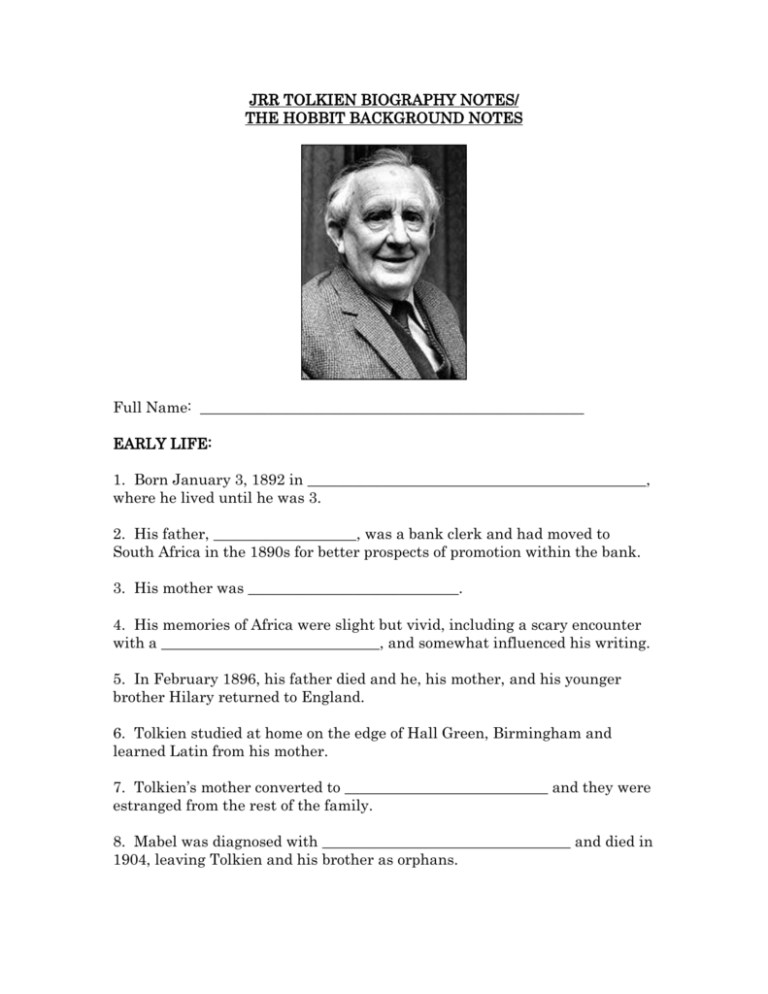
JRR TOLKIEN BIOGRAPHY NOTES/ THE HOBBIT BACKGROUND NOTES Full Name: ___________________________________________________ EARLY LIFE: 1. Born January 3, 1892 in _____________________________________________, where he lived until he was 3. 2. His father, ___________________, was a bank clerk and had moved to South Africa in the 1890s for better prospects of promotion within the bank. 3. His mother was ____________________________. 4. His memories of Africa were slight but vivid, including a scary encounter with a _____________________________, and somewhat influenced his writing. 5. In February 1896, his father died and he, his mother, and his younger brother Hilary returned to England. 6. Tolkien studied at home on the edge of Hall Green, Birmingham and learned Latin from his mother. 7. Tolkien’s mother converted to ___________________________ and they were estranged from the rest of the family. 8. Mabel was diagnosed with _________________________________ and died in 1904, leaving Tolkien and his brother as orphans. EDUCATION: 1. At age 12, Tolkien became a ward of a Catholic priest (Father Francis), and lived in a series of temporary arrangements and attended _____________ _______________________________ in Birmingham, where he mastered legend, literature, and language. He became fascinated by fantasy, folk, and mythology, and began to create __________________________________________ _______________________________ out of the fragmented English past (as seen in the Arthur legends, Sir Gawain, Beowulf and other Anglo-Saxon, and Medieval literature). 2. Tolkien mastered _______________________and became competent in a number of other languages ancient and modern, including Gothic, and Finnish. He began making up his own languages purely for fun. 3. At King Edward’s School, he made a number of close literary friends and they formed “TCBC—Tea Club Barrovian Society” named after their meeting place (Barrow Stores) where they would exchange writings and discuss literature. 4. While living in a boarding house run by Mrs. Faulkner, JRR Tolkien met and befriended ___________________. At the time, she was 19, and he was 16. 5. Father Francis saw their relationship blossoming, and forbid Tolkien to see her until he was 21. Tolkien obeyed this order to the letter. 6. He attended ________________________________ in 1911 and studied the Classics, Old English, the Germanic languages, Welsh and Finnish. 7. He resumed his relationship with Edith in 1913, and earned a B.A. in 1915. He earned an M.A. in 1919. 8. He and Edith married in 1916. 9. Tolkien taught and published great Anglo-Saxon and Medieval Literature, such as ____________________________________________________________. WAR 1. For the next three years, Tolkien served on the front lines in France with the Lancashire Fusiliers and was discharged with ______________________, which was a type of typhus-like infection common in many unsanitary conditions, he spent the next month in the hospital recovering. 2. During these months, all but one of his friends from the TCBS was killed in action, prompting him to begin crafting a story (Book of Lost Tales) which eventually became the basis for the Lord of the Rings, Silmarillion, and The Hobbit. He began to write about the tales of _____________________________ ______________________________________________________________. “In a hole in the ground there lived a hobbit…” 1. The Hobbit was originally published in__________. He decided to make up a story to answer the above statement that he had written on a blank page in a student’s exam that he was grading. 2. Originally told ______________________________________ and a manuscript eventually landed in the hands of a publisher who asked him to finish the story. 3. The Hobbit was an __________________________. 4. Tolkien became friends with many other writers of his day, particularly _________________________________, a fellow Christian and fantasy writer. 5. JRR Tolkien was asked to write something similar to The Hobbit, and came up with _____________________, but the publisher felt that this was not commercially viable and urged Tolkien to write The Hobbit 2. 6. ______________________________ series became the sequels to The Hobbit as the story of the ring evolved into a much larger story than even Bilbo Baggins’ original adventure. 7. Tolkien was humbled and grateful for the success of his books (The Hobbit, Fellowship of the Ring, Two Towers, Return of the King) but he was _____________________________________ that the fans of the books so closely associated the books with _______________________________________________. Fans, high on drugs would call Tolkien in the middle of the night to try to discuss Frodo and his adventures with him. Eventually he began to seclude himself somewhat from society to avoid all of the obsessive fans. 8. Tolkien continued to be a lecturer/professor on Medieval and Anglo-Saxon literature at Oxford University, and he died on ___________________________. KEY FACTS ABOUT THE HOBBIT: Narrator: The narrator is very playful and humorous, making the story easier to read. Setting: ____________________________________________________ Begins the story of _____________________________________ the central point about which the Lord of the Rings books revolves around. ARCHETYPES 1. _________________________—The Hobbit is first and foremost, the story of Bilbo Baggins and his becoming an unlikely hero. The story is filled with events that build Bilbo and draw out his inner character. Gandalf makes a claim early in the book that, “there is more to the little hobbit than meet the eye.” The major theme of all of Tolkien’s books is that heroes come in all shapes and sizes. As such, he uses the “unlikely hero/anti-hero, unexpected hero” archetype to define Bilbo. Bilbo’s inner character emerges when he is under pressure. Many critics feel that Tolkien’s war experiences shaped his view of humanity. 2. ________________________--Gandalf represents the archetype of the sage. The sage is the mentor of the hero. Sages are typically mysterious, old, powerful and wise. They often appear in the story to start the hero’s journey and training. 3. _______________________--Gollum represents the social outcast of the story. Social outcasts are often shunned by society. They live in the wilderness apart from society. They don’t really fit in with any group and are often a wild card in terms of what role they will play in the storyline— occasionally aligning with one side only to flip to join the other side when the moment is right. THEMES: 1. _______________________—the hero’s journey is the framework for the story. A hero must go on a journey, face trials along the way, and accomplish some great task. Bilbo’s journey is to the Lonely Mountain to help the dwarves recover their gold. His quest is to outsmart or defeat the dragon and serve as their burglar. 2. _____________________________________________—the differences between the various races in the novel are a major focus of the novel (dwarves, elves, hobbits, wizards, trolls, etc). The characters begin to learn to appreciate the differences in each other and work together for the common good. 3. ___________________________________________—Tolkien had a deep love for the old myths and fantasy stories from the Anglo-Saxons and the Medieval time period. Tolkien’s great love of these stories, particularly Beowulf, and Sir Gawain and the Green Knight, led to his desire to seeing this type of literature become popular again. Many of his character types and plot devices come directly from Beowulf and Sir Gawain and various other Anglo-Saxon and Medieval myths and legends. ((epic story, test of hero, mythological/supernatural characters, distant time and place, swords and wizrds, dragons, good vs. evil, etc.) 4. ______________________—Tolkien did not like__________________________ ___________________________________________. He wanted to tell a grand epic that the reader could enjoy. He did have influences and themes, but he didn’t want to preach, but rather sought to entertain in an enlightening way. 5. ________________________—Tolkien’s tremendous linguistic skills led him to create whole languages for his characters (elvish, etc.) His love of language also led to the style of his writing. 6. ________________________—Tolkien was well-known for being a Christian intellectual, and he and his friend C.S. Lewis sought to create great works of myth/folklore that would carry with them the great themes and messages of Christian theology. (temptation of the ring/sin to all characters, good vs. evil, all-powerful being, angelic-type characters (Gandalf, elves) that can fall into darkness (Saruman, orcs) and the humility with which Frodo undertakes his quest to destroy the ring and save Middle-Earth, which makes him a somewhat Christ-like character.) 7. Good Vs. Evil—Tolkien’s writing has a pretty strong focus on the cosmic struggle ______________________________________________________ working within _______________, ______________, and in the world (nature) itself. The innocence of the Hobbits mirrors a purity or goodness that contrasts with the darker more sinister characters of the story.
